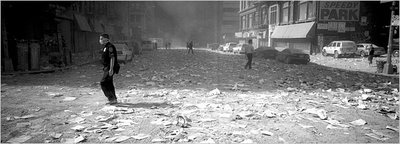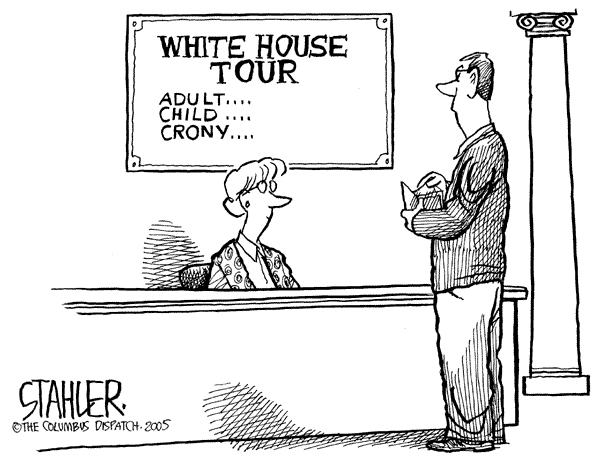
Even infuriating lists like this one which remind us of how the Republican war on regulation has killed, maimed and injured American workers:
Confined Space: Top Ten Workplace Safety Stories of 2006
A view from Main Street America by a congenital Democrat and truth-seeking attorney. Proud Member of the Reality-Based Community. Posting on the Internets since 2004.


With mounting evidence that exposure to the toxic smoke and ash at ground zero during the nine-month cleanup has made many people sick, attention is now focusing on the role of air-filtering masks, or respirators, that cost less than $50 and could have shielded workers from some of the toxins.
More than 150,000 such masks were distributed and only 40,000 people worked on the pile, but most workers either did not have the masks or did not use them.
[]
From legal documents presented in the case, a tale emerges of heroic but ineffective efforts to protect workers, with botched opportunities, confused policies and contradictions that failed to ensure their safety.
Lawyers representing the workers say that there was no central distribution point for the respirators, no single organization responsible for giving them out, and no one with the power to make sure the respirators that were distributed got used, and used properly.
By contrast, at the Pentagon, workers not wearing proper protective gear were escorted off the site.
The problem began with a statement by then EPA administrator Christie Todd Whitman assuring lower Manhattan workers and residents that the air was safe to breathe. DePalma reports that "the agency's inspector general concluded in 2003 that Ms. Whitman's statement was far too broad and could not be scientifically supported at the time she made it."
Personally, I think DePalma's being a bit too nice. The IG actually found that White House officials instructed the agency to be less alarming and more reassuring to the public in the first few days after the attack than EPA officials originally wanted to be. And earlier this year, Judge Deborah A. Batts of Federal District Court found that Whitman had deliberately mislead the public when she reassured the public after the collapse of the World Trade Centers that the air was safe to breathe in lower Manhattan and Brooklyn. The result of Whitman's lack of concern were devastating for recovery workers, according to Dave Newman of the New York Committee on Occupational Safety and Health who argues that after Whitman's statement, employers "had a green light to say, 'We don't need to use respirators because the E.P.A. says the air is OK.' "
[]
But the real culprit here is the Occupational Safety and Health Administration, the agency tasked by Congress to ensure the health and safety of American workers. And you can look long and hard at the Occupational Safety and Health Act without finding any exception for federally declared disasters:As the magnitude of the recovery operation grew clearer, attempts were made to bring order to the operation. On Sept. 20 the city issued its first safety plan, and it asked the Occupational Safety and Health Administration to take charge of distributing respirators. In what would become a controversial move, OSHA used its discretionary powers to decide not to enforce workplace safety regulations but to act in a supportive role that would not slow down operations.

On the other hand, the history of the Bush administration, from the botched reconstruction of Iraq to the botched start-up of the prescription drug program, shows that a president who isn't serious about governing, who prizes loyalty and personal connections over competence, can quickly reduce the government of the world's most powerful nation to third-world levels of ineffectiveness.
And bear in mind that Mr. Bush's pattern of cronyism didn't change after Katrina. For example, he appointed Julie Myers, the inexperienced niece of Gen. Richard Myers, to head Immigration and Customs Enforcement — an agency that, like FEMA, is supposed to protect us against terrorism as well as other threats. Even at the C.I.A., the administration seems more interested in purging Democrats than in improving the quality of intelligence.
So let's skip the name change for FEMA, O.K.? The United States will regain effective government if and when it gets a president who cares more about serving the nation than about rewarding his friends and scoring political points. That's at least a thousand days away. Meanwhile, don't count on FEMA, or on any other government agency, to do its job.

90 percent of the abortions in Africa are done using terrifying methods: “inserting sharp objects into the uterus, flushing the vagina with caustic liquids, throwing oneself from high places or repeated blows to the abdomen.”
Just horrible.
Iraq War veteran who received Purple Heart says Army is making him repay money
When Fontana resident and 2001 Fontana A.B. Miller High School graduate Kevin Stonestreet joined the U.S. Army in the summer of 2001 as a member of the infantry, he was given a $20,000 bonus to be paid out over his six-year enlistment.
However, when Stonestreet was honorably discharged from the Army in 2005, he found out he needed to repay $3,800 of that bonus because he did not complete his six years.
But Stonestreet, who is now 23, said he was kicked out of the Army because he was diagnosed with post traumatic stress disorder, anxiety and depression from serving in Iraq.
In addition, Stonestreet, who was awarded the Purple Heart and was considered for the Bronze Star for bravery in combat, said the amount he was to pay back was originally $6,000, but the government repossessed his final paycheck of $2,200.
"They were nice enough to take out the $170 for my child support," Stonestreet said, laughingly.
There are no good days in the American workplace.
Still, it seems like some days are worse than others. This is a small sampling of what arrived in my in-box today:
OSHA investigates Metro East man's workplace deathSAUGET, Ill. Federal workplace-safety officials are investigating a man's death while he worked at a Metro East plant.
Police say 27-year-old J-D Croom of Cahokia died yesterday when he was sucked into a large machine at the Mid-America Fiber Company plant in Sauget.
Worker Dies After He Is Pulled Into MachineNEW HAVEN -- A worker died after he was pulled into a machine at a scrap metal yard Wednesday, police said.
The accident occurred at about 4:15 p.m. at Regan Metal Corp., 69 Poplar St., police said. Richard Larson, 54, of Kensington, was taken to Yale-New Haven Hospital, where he was pronounced dead at 4:45 p.m., Sgt. Robert Dudley said.
Police said Larson was loading metal into a machine that coils the metal. His work glove apparently got caught in the machine when he went to adjust a bar, and the machine pulled him in, Sgt. Andrew Muro said.
OSHA is to review fatal work accident
BRUNSWICK HILLS TWP. - The federal Occupational Safety & Health Administration is expected to probe Tuesday's death of a delivery man crushed by about a ton of granite slabs.
Owatonna man killed in job accidentOWATONNA, Minn. — A 25-year-old Owatonna man died in a workplace accident, police said Wednesday.
Patrick Donahue was pinned under a crate that weighed nearly a ton while working in the shipping area at Viracon Inc., an architectural glass fabricator based in Owatonna.
White Mills Man Dies In Construction Accident(RADCLIFF, Ky.) -- A construction worker died on Thursday morning when the trench he was working in collapsed on top of him.
Tommy Hensley, 42, was standing about eight feet deep in the trench in a new construction site off Hill Street when the sides of the trench caved in, Radcliff Police spokesman Bryce Shumate said.
Days like this always bring to mind the wise words of the Chairman of the Senate Committee on Health, Education, Labor and Pensions, Senator Michael Enzi (R-WY):Cooperation, not confrontation is essential in making our workplaces safer. The notion that employers care little about worker safety, or are prepared to sacrifice worker health in the pursuit of profit is a dangerous myth.
In fact, most employers are concerned for the welfare of their employees and are fully prepared to comply with laws aimed at enhancing their safety on the job.

OSHA has not said what the new limit will be. But sources close to the agency have been told to expect a standard that would allow five times more exposure than it had initially proposed -- a shift that would be a victory for the industry, saving it billions of dollars in upgrades and plant closures.
The decades-old "permissible exposure level" is 52 micrograms per cubic meter of air. On the basis of the few large studies done in recent years, advocates sought a new level of 0.25 micrograms. In 2004, OSHA released a proposed limit of 1 microgram.
According to OSHA, the 1 microgram limit would result in two to nine excess deaths in every 1,000 exposed workers over a 45-year lifetime of work. That is more than the one-death-per-1,000 standard the agency aims for but is reasonable, it said, in light of the high costs and technological challenges involved.
OSHA calculated that a less stringent limit of 5 micrograms per cubic meter would result in 10 to 45 excess deaths per 1,000 workers.
[T]he industry conducted a pivotal study that found a fivefold increase in lung cancer deaths from moderate exposures to chromium but never published the results or gave them to OSHA. Company-sponsored scientists later reworked the data in a way that made the risk disappear.
Scientists working for the chromium industry withheld data about the metal's health risks while the industry campaigned to block strict new limits on the cancer-causing chemical, according to a scientific journal report published yesterday.
Time and again over the past four years, federal mining inspectors documented the same litany of problems at central West Virginia's Sago Mine: mine roofs that tended to collapse without warning. Faulty or inadequate tunnel supports. A dangerous buildup of flammable coal dust.
[]
In the past two years, the mine was cited 273 times for safety violations, of which about a third were classified as "significant and substantial," according to documents compiled by the Labor Department's Mine Safety and Health Administration (MSHA). Many were for problems that could contribute to accidental explosions or the collapse of mine tunnels, records show.
[]
Other inspection reports over the past two years fault the mine for "combustibles," including a buildup of flammable coal dust and a failure to adequately insulate electric wires. Sparks from electrical equipment can ignite coal dust and methane gas, triggering fires and explosions.
The mine is contesting some of the violations, while agreeing to pay more than $24,000 in penalties to settle others.